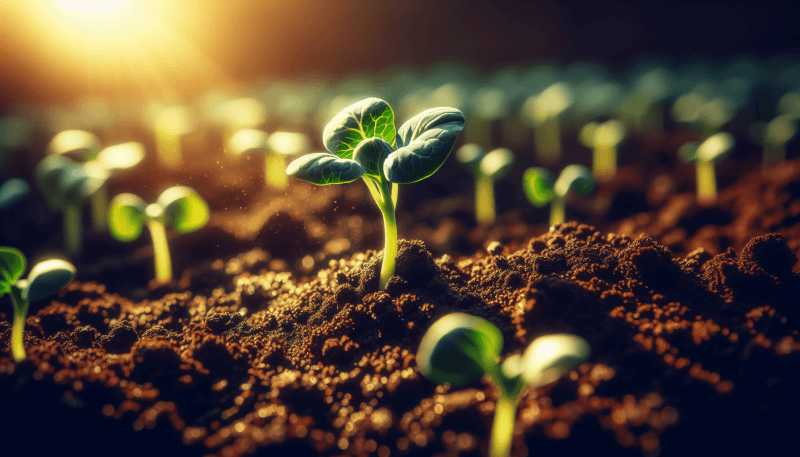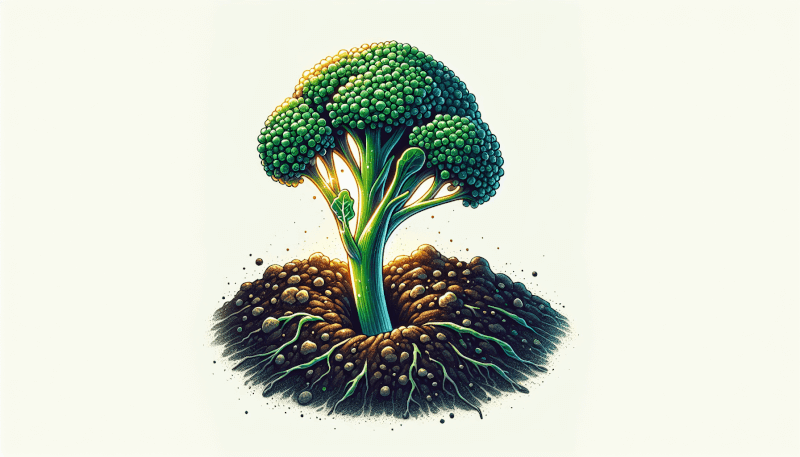👋 Click the mic button to talk to Alfred, the Todd's Seeds Gardening/Sprouting Expert – Feel free to ask him anything!
Ask Virtual Todd Anything - Click the Mic
Broccoli seeds’ germination temperature plays a crucial role in the successful growth of this nutrient-packed vegetable. Understanding the ideal conditions for germination can greatly increase your chances of a bountiful broccoli harvest. In this article, you will discover the optimal temperature range for germinating broccoli seeds, helping you set the stage for healthy and thriving plants in your garden. So, put on your gardening gloves and let’s explore the world of broccoli seeds germination temperature together!
Ideal Germination Temperature
The Importance of Temperature
When it comes to germinating broccoli seeds, temperature plays a crucial role in the success of the process. Temperature affects the overall viability of the seeds, the speed at which they germinate, and the health of the resulting seedlings. Understanding the ideal germination temperature is essential for achieving maximum germination rates and producing strong, healthy broccoli plants.
Optimal Temperature Range
The optimal temperature range for germinating broccoli seeds falls between 70°F and 85°F (21°C and 29°C). Within this temperature range, the seeds are more likely to germinate quickly and uniformly. It is important to note that different varieties of broccoli may have slightly different optimal temperature ranges, so it is essential to consider this when selecting the variety you want to grow.
Effects of Temperature on Germination
Temperature directly affects the rate of chemical reactions within the seeds. While low temperatures may slow down or inhibit germination, high temperatures can cause the seeds to dry out or become dormant. By maintaining the ideal germination temperature, you provide the optimal conditions for the seeds to absorb water, activate enzymes, and initiate the growth process.
Factors Affecting Germination Temperature
Varieties of Broccoli
Different varieties of broccoli may have varying temperature preferences for germination. For example, Calabrese broccoli typically prefers a slightly lower temperature range of 60°F to 70°F (15°C to 21°C) for optimal germination. Romanesco broccoli, on the other hand, prefers a temperature range similar to that of the standard broccoli varieties.
Climate and Region
The climate and region in which you are growing broccoli can also impact the germination temperature. If you are in a cooler climate, you may need to provide additional heat sources to maintain the optimal germination temperature. Conversely, if you are in a region with hot summers, you may need to take extra precautions to ensure that the seeds do not experience excessive heat that can hinder germination.
Seeding Method
The method used for seeding can also affect the germination temperature requirements. Direct seeding, where the seeds are planted directly into the soil, may require slightly different temperature conditions compared to starting the seeds indoors and transplanting later. It is important to consider the specific germination requirements for each method of seeding to ensure successful results.

Temperature Requirements for Germination
Minimum Germination Temperature
The minimum germination temperature refers to the lowest temperature at which the seeds can begin the germination process. For broccoli seeds, the minimum germination temperature is commonly around 40°F (4°C). While germination can occur at this temperature, it may be slower and less uniform compared to the optimal temperature range.
Maximum Germination Temperature
The maximum germination temperature represents the highest temperature at which the seeds can still germinate successfully. For most broccoli varieties, this temperature is around 95°F (35°C). Temperatures exceeding this limit can cause the seeds to become dormant or, in extreme cases, result in their death.
Recommended Germination Temperature
To ensure the best germination rates and overall success, it is advisable to aim for the recommended germination temperature range of 70°F to 85°F (21°C to 29°C) for broccoli seeds. This range provides the ideal conditions for the seeds to germinate quickly and develop strong, healthy seedlings.
Temperature Control Methods
Indoor Germination
If you choose to start your broccoli seeds indoors, you have more control over the temperature conditions. To ensure optimal germination temperature, you can place the seed trays on a heated propagator or use a heating mat specifically designed for seed starting. These devices provide consistent warmth to the seeds, promoting faster and more uniform germination.
Outdoor Germination
When germinating broccoli seeds outdoors, it can be more challenging to control the temperature. However, you can utilize various techniques to maintain optimal conditions. Positioning the seeds in a sunny location can help to provide natural warmth. Additionally, using light-colored or reflective mulch around the seeds can prevent excessive heat buildup, thus keeping the temperature within the desired range.
Using Heating Mats
Heating mats are a popular and effective method for controlling germination temperature. These mats are placed beneath the seed trays or pots and provide gentle, consistent heat to the seeds. By using a thermostat or temperature controller with the heating mat, you can regulate and maintain the desired germination temperature more accurately.
Ventilation and Air Circulation
Proper ventilation and air circulation are crucial for maintaining a suitable germination temperature. Stagnant air can lead to temperature fluctuations and create an environment that is too warm or too cold for the seeds. Adequate ventilation assists in temperature regulation and helps prevent the growth of mold or fungal diseases.

Germination Time and Temperature
Germination Timeframe
The germination time for broccoli seeds can vary depending on the temperature conditions and specific variety. Under optimal temperature conditions, broccoli seeds generally germinate within 5 to 10 days. However, in cooler temperatures, it may take longer, and in warmer temperatures, germination can occur more quickly.
Temperature Adjustments
To adjust the germination time, you can slightly modify the temperature. Increasing the temperature within the optimal range can expedite germination, while lowering the temperature can slow it down. However, it is essential to maintain the recommended temperature range for the best results and to ensure the health and vigor of the resulting seedlings.
Progress Monitoring
Regular monitoring of the germination process is crucial to ensure that the temperature remains within the desired range and that the seeds are developing properly. By checking the seed trays or pots, you can identify any abnormalities, such as slow germination or uneven growth, and make necessary adjustments to the temperature conditions if needed.
Effects of Incorrect Germination Temperature
Slow Germination or No Germination
One of the most common effects of incorrect germination temperature is either slow germination or no germination at all. If the temperature is too low, the seeds may take much longer to germinate, leading to delayed growth and potential vulnerability to diseases. Conversely, if the temperature is too high, the seeds may not be able to initiate the germination process, resulting in a complete failure to germinate.
Disease and Fungal Growth
Incorrect germination temperatures can also promote the growth of diseases and fungi. In conditions that are too cold or too hot, the seeds may become more susceptible to fungal infections and diseases. These infections can hinder germination, weaken the seedlings, and potentially lead to plant diseases later in the growth cycle.
Seedling Weakness
Suboptimal germination temperatures can result in weak and fragile seedlings. Extreme temperatures, whether too hot or too cold, can stress the seeds and compromise their ability to develop into strong and healthy plants. Weak seedlings are more susceptible to diseases, environmental stresses, and other factors that can impede their growth and overall success.
Germination Temperature for Specific Broccoli Varieties
Calabrese Broccoli
Calabrese broccoli, a popular variety known for its large heads, prefers a slightly lower germination temperature range of 60°F to 70°F (15°C to 21°C). It is important to provide these cooler conditions to ensure optimal germination rates and promote healthy growth.
Romanesco Broccoli
Romanesco broccoli, known for its striking appearance and unique fractal pattern, has similar germination temperature requirements as standard broccoli varieties. It thrives within the preferred temperature range of 70°F to 85°F (21°C to 29°C) and requires consistent warmth for successful germination.
Broccolini
Broccolini, a hybrid between broccoli and Chinese kale, generally follows the same germination temperature guidelines as standard broccoli varieties. Aim to maintain a temperature range between 70°F and 85°F (21°C and 29°C) to promote efficient germination and ensure robust growth.
Adjusting Temperature for Different Growth Stages
Seedling Stage
During the seedling stage, it is essential to maintain a consistent and appropriate temperature. Gradually reducing the temperature as the seedlings develop can help strengthen their growth. Aim for a temperature range between 60°F and 70°F (15°C and 21°C) during this stage to encourage steady growth and prepare the seedlings for transplantation.
Transplanting Stage
When transplanting broccoli seedlings, it is important to ensure that the temperature remains within the recommended range of 70°F to 85°F (21°C to 29°C). This temperature range provides the ideal conditions for a smooth transition, allowing the plants to establish themselves quickly and minimize transplant shock.
Mature Plant Stage
Once the broccoli plants reach the mature stage, they become more resilient to temperature variations. However, it is still important to maintain a temperature range between 60°F and 75°F (15°C and 24°C) to promote optimal growth and quality yield. Extreme temperature fluctuations during flowering or head formation can potentially affect the final harvest.
Common Germination Temperature Issues
Inconsistent Temperature
Inconsistencies in temperature can lead to uneven germination and overall poor seedling development. It is crucial to maintain a consistent temperature within the recommended range throughout the germination process. Regularly monitoring and adjusting temperature fluctuations can help prevent this issue and ensure more successful germination rates.
Extreme Temperature Fluctuations
Extreme fluctuations in temperature can have detrimental effects on the germination process. Rapid temperature changes can shock the seeds and hinder their ability to germinate. It is important to avoid exposing the seeds to rapid temperature shifts, especially when transitioning between indoor and outdoor environments.
Inadequate Monitoring
Failure to monitor the germination temperature can result in delays, poor growth, and weakened seedlings. Regularly checking the temperature levels using a thermometer or temperature controller is crucial to maintain the correct conditions. By monitoring the temperature, you can make timely adjustments and ensure the optimal growth of your broccoli seeds.
Tips for Successful Broccoli Seed Germination
Read Seed Packet Instructions
Always check the seed packet instructions for specific germination temperature requirements for the variety of broccoli you are growing. Different varieties may have specific temperature preferences, and following these instructions will help maximize germination rates.
Prepare the Germination Environment
Before sowing your broccoli seeds, prepare the germination environment. Ensure that the soil or seed starting mix is well-draining and moist but not overly saturated. Providing the appropriate growing medium sets the stage for successful germination.
Maintain Consistent Temperature
Throughout the germination process, maintain a consistent temperature within the recommended range. Consider using heating mats or other temperature-regulating devices to create the ideal conditions. Consistency is key to achieving the highest germination rates and producing healthy seedlings.
Provide Proper Lighting
In addition to temperature, lighting conditions also play a role in seed germination. Ensure that your broccoli seeds receive adequate light, either natural sunlight or supplemental grow lights. Proper lighting encourages uniform growth and helps prevent leggy or weak seedlings.
Monitor Moisture Levels
While temperature is important, it is equally crucial to monitor the moisture levels. Ensure that the germination environment remains consistently moist but not waterlogged. Regularly check the soil’s moisture using your finger or a moisture meter and adjust the watering accordingly.
Handle Seedlings with Care
Once your broccoli seeds have germinated and the seedlings begin to emerge, handle them with great care. Use a gentle touch to transplant them into individual pots or containers, taking care not to damage the delicate roots. Providing careful attention during this stage helps ensure that the seedlings continue to grow strong and healthy.
By understanding and maintaining the ideal germination temperature for your broccoli seeds, you can increase your chances of successful germination, robust seedling development, and ultimately, a bountiful harvest of delicious broccoli. With the right temperature control methods and careful observation, you can create the optimal conditions for your broccoli seeds to thrive. Happy germinating!